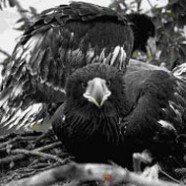
Problem/Background
At present, the world’s population of Steller’s sea eagles (Haliaeetus albicilla, SSE) appears to be stable and not endangered; however, this species is listed as a Bird to Watch. Its breeding range is located within remote, restricted areas in Russia – areas where access can be achieved only by air or sea. Indeed, it is likely that the very remoteness of these areas has protected the Steller’s sea eagle from large-scale human interference, and in-depth scientific scrutiny.
The Steller’s sea eagle is the largest of all the sea eagles, weighing between 5 and 9 kg with a wingspan of 2.2-2.45 m. It breeds along the seacoasts and rivers of northeastern Siberia and in northern Korea. Part of the population over-winters in the breeding range, concentrating around rivers and parts of the sea that remain ice-free. Other groups move south to Japan, Korea, and along the coast of the Russian mainland. Steller’s sea eagles feed primarily upon fish (e.g., salmon), although they will also take medium-large birds (seabirds, capercaillie, ptarmigan, and geese), mammals (hares, fox, seals), invertebrates (crabs and mollusks), and carrion.

Steller's sea eagle
The Steller’s sea eagle enjoys legal protection in some of the areas in which it is found. Within Russia, it is a Red Data Book species; in theory it has complete protection there, though enforcement of this sort of protection is virtually impossible. In Japan, the species is designated a National Monument and is given complete protection. In China and Korea, no legislation is known to protect these birds as breeders, migrants, or over-wintering birds; politics and the need for increased foreign investment have opened up isolated areas for increased human exploitation. As a result, the areas in which this eagle lives and breeds may not remain relatively pristine. It is also inevitable that development will come to far-eastern Russia; because few roads exist there, it is most likely that development will establish itself first along the sea and rivers, the very places where these great sea eagles breed.
Approach/Objectives
The use of satellite tracking is particularly appropriate for studying this species, given the remote areas in which it lives. CCRT has been studying the migration and wintering behavior of Steller’s sea eagles, as well as their distribution and breeding dynamics.
During the spring of 1997, we outfitted fourteen Steller’s sea eagles with satellite PTTs. We monitored the movements of these sea eagles via the Argos satellite system (see map below). This study is the first PTT application to Steller’s sea eagles, and the results will prove invaluable in the conservation of this rare species.
Map of Steller’s Sea Eagle Movements in Far Eastern Russia

Map of Steller's Sea Eagle Movements in Far Eastern Russia
